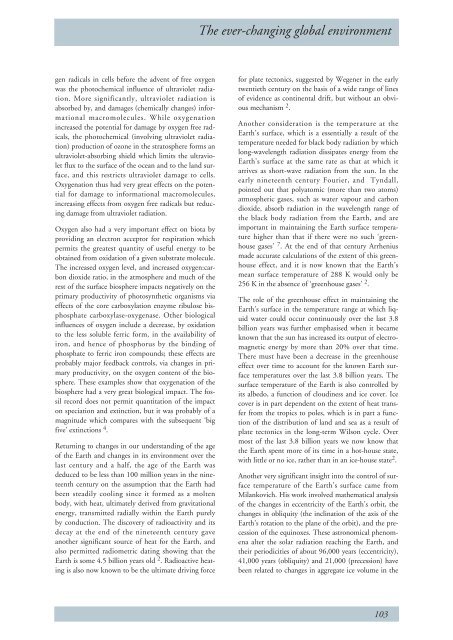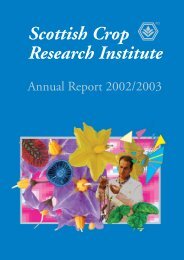SCRI Annual Report 2003/2004 - Scottish Crop Research Institute
SCRI Annual Report 2003/2004 - Scottish Crop Research Institute
SCRI Annual Report 2003/2004 - Scottish Crop Research Institute
Create successful ePaper yourself
Turn your PDF publications into a flip-book with our unique Google optimized e-Paper software.
The ever-changing global environment<br />
gen radicals in cells before the advent of free oxygen<br />
was the photochemical influence of ultraviolet radiation.<br />
More significantly, ultraviolet radiation is<br />
absorbed by, and damages (chemically changes) informational<br />
macromolecules. While oxygenation<br />
increased the potential for damage by oxygen free radicals,<br />
the photochemical (involving ultraviolet radiation)<br />
production of ozone in the stratosphere forms an<br />
ultraviolet-absorbing shield which limits the ultraviolet<br />
flux to the surface of the ocean and to the land surface,<br />
and this restricts ultraviolet damage to cells.<br />
Oxygenation thus had very great effects on the potential<br />
for damage to informational macromolecules,<br />
increasing effects from oxygen free radicals but reducing<br />
damage from ultraviolet radiation.<br />
Oxygen also had a very important effect on biota by<br />
providing an electron acceptor for respiration which<br />
permits the greatest quantity of useful energy to be<br />
obtained from oxidation of a given substrate molecule.<br />
The increased oxygen level, and increased oxygen:carbon<br />
dioxide ratio, in the atmosphere and much of the<br />
rest of the surface biosphere impacts negatively on the<br />
primary productivity of photosynthetic organisms via<br />
effects of the core carboxylation enzyme ribulose bisphosphate<br />
carboxylase-oxygenase. Other biological<br />
influences of oxygen include a decrease, by oxidation<br />
to the less soluble ferric form, in the availability of<br />
iron, and hence of phosphorus by the binding of<br />
phosphate to ferric iron compounds; these effects are<br />
probably major feedback controls, via changes in primary<br />
productivity, on the oxygen content of the biosphere.<br />
These examples show that oxygenation of the<br />
biosphere had a very great biological impact. The fossil<br />
record does not permit quantitation of the impact<br />
on speciation and extinction, but it was probably of a<br />
magnitude which compares with the subsequent ‘big<br />
five’ extinctions 4 .<br />
Returning to changes in our understanding of the age<br />
of the Earth and changes in its environment over the<br />
last century and a half, the age of the Earth was<br />
deduced to be less than 100 million years in the nineteenth<br />
century on the assumption that the Earth had<br />
been steadily cooling since it formed as a molten<br />
body, with heat, ultimately derived from gravitational<br />
energy, transmitted radially within the Earth purely<br />
by conduction. The discovery of radioactivity and its<br />
decay at the end of the nineteenth century gave<br />
another significant source of heat for the Earth, and<br />
also permitted radiometric dating showing that the<br />
Earth is some 4.5 billion years old 2 . Radioactive heating<br />
is also now known to be the ultimate driving force<br />
for plate tectonics, suggested by Wegener in the early<br />
twentieth century on the basis of a wide range of lines<br />
of evidence as continental drift, but without an obvious<br />
mechanism 2 .<br />
Another consideration is the temperature at the<br />
Earth’s surface, which is a essentially a result of the<br />
temperature needed for black body radiation by which<br />
long-wavelength radiation dissipates energy from the<br />
Earth’s surface at the same rate as that at which it<br />
arrives as short-wave radiation from the sun. In the<br />
early nineteenth century Fourier, and Tyndall,<br />
pointed out that polyatomic (more than two atoms)<br />
atmospheric gases, such as water vapour and carbon<br />
dioxide, absorb radiation in the wavelength range of<br />
the black body radiation from the Earth, and are<br />
important in maintaining the Earth surface temperature<br />
higher than that if there were no such ‘greenhouse<br />
gases’ 7 . At the end of that century Arrhenius<br />
made accurate calculations of the extent of this greenhouse<br />
effect, and it is now known that the Earth’s<br />
mean surface temperature of 288 K would only be<br />
256 K in the absence of ‘greenhouse gases’ 2 .<br />
The role of the greenhouse effect in maintaining the<br />
Earth’s surface in the temperature range at which liquid<br />
water could occur continuously over the last 3.8<br />
billion years was further emphasised when it became<br />
known that the sun has increased its output of electromagnetic<br />
energy by more than 20% over that time.<br />
There must have been a decrease in the greenhouse<br />
effect over time to account for the known Earth surface<br />
temperatures over the last 3.8 billion years. The<br />
surface temperature of the Earth is also controlled by<br />
its albedo, a function of cloudiness and ice cover. Ice<br />
cover is in part dependent on the extent of heat transfer<br />
from the tropics to poles, which is in part a function<br />
of the distribution of land and sea as a result of<br />
plate tectonics in the long-term Wilson cycle. Over<br />
most of the last 3.8 billion years we now know that<br />
the Earth spent more of its time in a hot-house state,<br />
with little or no ice, rather than in an ice-house state 2 .<br />
Another very significant insight into the control of surface<br />
temperature of the Earth’s surface came from<br />
Milankovich. His work involved mathematical analysis<br />
of the changes in eccentricity of the Earth’s orbit, the<br />
changes in obliquity (the inclination of the axis of the<br />
Earth’s rotation to the plane of the orbit), and the precession<br />
of the equinoxes. These astronomical phenomena<br />
alter the solar radiation reaching the Earth, and<br />
their periodicities of about 96,000 years (eccentricity),<br />
41,000 years (obliquity) and 21,000 (precession) have<br />
been related to changes in aggregate ice volume in the<br />
103
















